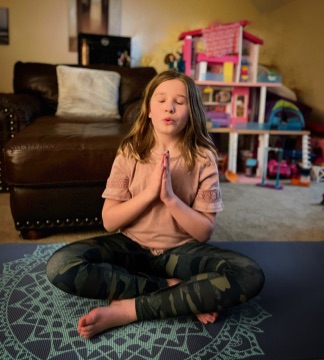I teach sixth grade, and every day I share a thought for the day (a positive quote) with my students. Today’s thought was “One of the greatest addictions people have is the addiction to thought.” I talked to them about how when we think about addiction, we usually think about being addicted to video games or soda or TV, but thinking can also be an addition. In fact, these days most of us can find ourselves addicted to thinking, especially negative thoughts. I asked students if they ever have a hard time falling asleep because they can’t shut their brains off. In all four of my classes, every hand went up. I asked if they would like to know a way to stop it, and I had their full attention.
I had them do an experiment. I had them close their eyes and listen for a sound: the sound of the heating/air unit. It makes a soft white noise sound. Then I asked if they noticed that while they were listening, they weren’t thinking any other thoughts. They agreed that was true.
I explained they could practice that same process at home at night when they’re trying to go to sleep. I also used the word “meditation” at this point and several kids made faces at me. I asked them if when I said the word “meditation” they thought of sitting in a cross-legged position and saying “ohm” and they laughed. I explained that meditation isn’t really about that, that it’s quieting the mind.
Then I asked if anyone had a sound machine in their room. Some said yes, but most didn’t know what a sound machine was. I explained that sound machines can play ocean wave sounds (my favorite), white noise (and what that means), thunderstorms (my father-in-law’s favorite), and one with crickets and birds chirping, which I would personally find annoying. Some students shared that you can have Amazon Alexa play ocean or beach sounds too.
I encouraged them to try this and really focus on listening to and really focusing on whatever white noise sound they chose, then to let me know if it made a difference for them.
We also talked about how tapping in to any of the five senses can help bring you back to the present moment. You can feel the fabric of your jeans or shirt. Like when I’m driving, I will feel the texture of the steering wheel or the fabric of the seat and it will calm me and ground me. In my classroom, during cold weather months, I play a video of a fireplace during classwork time, and during warmer months, I play a video of ocean waves or beach scenery. Both of these are calming and students tell me they help them to be calm and to “turn their brain off” of whatever may be bothering them. Then they can refocus and get back to work.
Our brains tend to have so many tabs open and we can feel so overwhelmed that we don’t know where to start. By practicing mindfulness and having techniques to stop thought, we can turn off the tape playing in our minds of what has already happened or things that we may be anxious about happening in the future. We can be here. Now. In the moment. Namaste.

